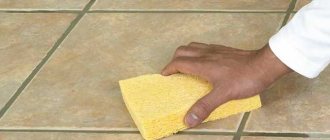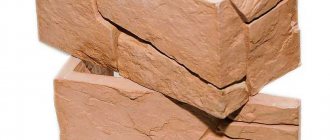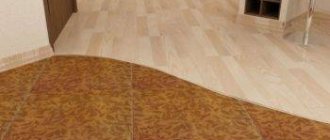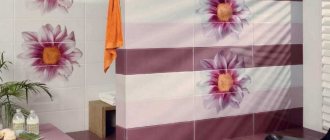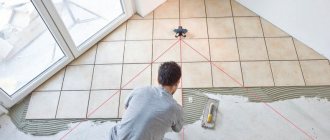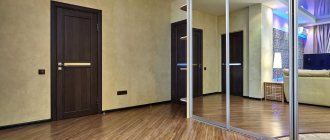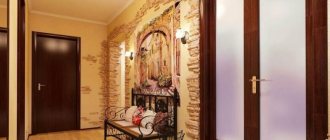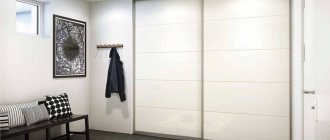The style of home design begins from the entrance area. You shouldn't literally finish the hallway first. However, it is important to remember that poor execution of the floor and other parts of the corridor will destroy the integrity of the interior of the entire apartment. An effect such as the first impression is also formed by the hallway, and gender plays a key role in this perception. Tile is the preferred option for finishing a room. It is easy to clean and tolerates temperature contrasts well when opening the front door. Moreover, it copes perfectly with the load from moving bulky objects. Tiles are now made in different colors, styles, textures and shapes; monotonous tiles are a thing of the past. Functionality and creativity are components of a successful tile choice. By modern standards, ordinary ceramic tiles on the floor in the hallway are a stylish and reliable option.
Requirements for hallway flooring
The floor in the hallway constantly gets dirty, and in winter it is subjected to pressure from heavy shoes. Sand, salt, snow and water come from the street 365 days a year. In this regard, the type of coating is chosen before the main part of the renovation and before the start of decorating the room. Requirements for floor finishing include high strength, moisture resistance, ease of maintenance, resistance to stains and dirt accumulation. Experts add to the general recommendations such a parameter as durability, in other words, wear resistance. The most unsuitable types of flooring include natural parquet boards and artificial parquet. The floor made from the listed materials gradually deforms due to contact with water. At the same time, ceramic tiles, porcelain tiles and linoleum are considered the best options.
Ceramic tiles, porcelain tiles and quartz vinyl tiles
Often the tiles that are well known to us are confused with similar coatings, namely:
- porcelain stoneware , which is produced on the basis of several types of clays with the addition of granite, feldspar or quartz. The result is a material that is almost as strong and wear-resistant as natural stone. Porcelain tile is unlikely to break even if a heavy object falls, but it is not cheap, and many experts believe that it is too durable for an ordinary residential apartment;
- quartz vinyl tiles are somewhat reminiscent of ordinary tiles, but during the production process plasticizers, stabilizers and pigments are added to quartz sand. The basis still remains quartz, which gives manufacturers grounds to claim that the material is natural and harmless. Polymer additives make the coating more flexible and impact resistant. In principle, this is a very good option for a corridor, but the range of such tiles is much more modest than tiled ones;
- "golden" tile has become a real bestseller in South Korea and is beginning to conquer the domestic market. This is a multi-layer coating. At the bottom there is compacted PVC, then there is a layer of crushed stone mixed with resin, then fiberglass and a film with a pattern. The principle is similar to laminate, but the result is a more durable and reliable coating that can imitate any type of stone or wood.
Advantages and disadvantages
The first useful feature of the tile is its adaptability to conditions of increased pollution. The smooth surface is also easy to clean. With high-quality and dense installation, the tile covering exhibits increased resistance to impacts and heavy loads. Fireproof properties are guaranteed by the surface structure. For hot regions with a high risk of wildfires, it is important that flames cannot spread on the floor. In addition, the tiles cool the room on the warmest summer days, both in the north and south. Repairing a fragment of a tile composition is much easier than restoring the integrity of alternative types of coatings - another plus. Thanks to environmentally friendly materials, tiles do not pose any threat to human health. Some points are still negative. However, there are not many of them: poor sound insulation, slippery surface, possible violation of integrity due to poor installation.
The finishing materials market has long had tiles with a coating that prevents slipping and reduces other defects to a minimum.
About the pros and cons
The basic properties of tiles are familiar to many of us due to their widespread use. This is an ideal material for a hallway, as it has the following advantages:
- durability _ It’s worth spending once on the purchase and installation of a coating, and it will serve you for decades, subject to normal care;
- ease of care . Keeping the tiles clean is not difficult, you can use a lot of detergents, and dirt can even be scrubbed off with brushes;
- moisture resistance;
- wear resistance Tiles don’t care about heels, sand, or abrasive cleaners;
- hygiene;
- a wide selection of colors, patterns, formats, so there will be no difficulties in decorating the hallway in a certain color or style.
about the disadvantages in advance.
- Firstly, this is a cold material , so you won’t be able to walk barefoot in winter, but with the help of ordinary slippers this problem can be solved.
- Secondly, tiles are characterized by fragility : if you drop something heavy, there is a high probability that the material will be damaged.
If the hallway is of impressive size, then a tiled floor can add excessive severity and resemble the lobby of a government institution. There are several ways out of the situation: use a combination of tiles with other finishing materials or turn to warm, cozy colors.
Types of floor tiles in the hallway
The main options are ceramic, quartz vinyl tiles, and porcelain tiles. The first variety is classic, with good hygiene and durability. The second option is an improved material made from several layers. The third subspecies has a granular structure and decorative properties. There are also alternative options for decorating the floor in the hallway. Clinker tiles, for example, are known for their high resistance to low temperatures. Terraglia is white in color, so it is suitable as a basis for drawings. Cotto tiles have a brick tone and are a great option for an antique look. Metlakhskaya is an unglazed pressed tile of one-time firing. It is painted through and through, so the designs are especially durable. To finish the floors in the hallway, tiles with a solid and porous base, as well as with mono- and bicottura technology, are used.
Ceramic
One of the most popular materials for flooring. Ceramic tiles demonstrate high levels of hygiene - dirt does not adhere well to its surface. The tile is resistant to abrasion and can have decorative qualities. The surface itself is not only matte or glossy. Now on sale there are lapped, polished, embossed and glazed options. In addition, there are about ten types of ceramic tiles, depending on the material and manufacturing technology. According to the moisture resistance parameter, only 3 categories are distinguished. Low moisture absorption corresponds to high frost resistance, therefore, the tiles of the first group are of the highest quality, while the second and third groups have average and low performance. In addition, ceramic tiles do not conduct electricity and are resistant to fire. The use of this option is justified not only in the hallway, but also in the kitchen.
Porcelain tiles
An excellent finishing material for giving the room “individuality”. In addition, properly installed porcelain tiles will eliminate any surface imperfections. The cladding made of this material tolerates mechanical stress well. According to the Friedrich Mohs scale, different types of porcelain stoneware have strength from 5 to 8 points, with an average of 7. The material is “not afraid” of chemical reagents. You just need to avoid contact with hydrofluoric acid on the surface. Porcelain stoneware finishes can withstand frequent temperature contrasts, which makes the characteristics of the material optimal for hallways. Manufacturers produce products with thicknesses from 7 to 30 mm for different conditions, so there is an option for every case. The most popular sizes of porcelain tiles are 30×30 and 60×60 cm. When choosing cladding among this subtype of tile, complete consistency with the style of the room is important.
Quartz vinyl
This type of tile is created using elastic and hard material and is an improved type of PVC coating. Despite their intended purpose for places where there are large crowds of people, tiles are used to decorate floors in hallways and long corridors. Quartz vinyl is a combined material of several layers. The first layer is polyvinyl chloride (PVC), which ensures reliable adhesion to the surface being treated. Next comes glass fiber to increase the maximum load-bearing capacity. The third layer consists of quartz and vinyl - reinforces and gives strength. Above are the decorative layer and the protective polyurethane layer - the top one. Quartz vinyl tiles are easily restored after damage, can be used with electric floors and have a number of other advantages. Among other things, the material insulates sound better than other types of tiles.
Choosing floor tiles - the best manufacturers
There are several companies on the modern market that have proven themselves to be of high quality products:
- Kerama Marazzi is a Russian manufacturer offering a wide range of tile types at budget prices. The company's collections are oriented around the world, so the variety of products makes it easy to select tiles for a wide variety of interiors. The quality of the tiles is considered one of the best in the middle price segment; innovative technologies are used in production.
- Shakhty tiles are Russian tiles, very popular due to their low prices. The quality is quite high for the budget segment, the products are distinguished by a large number of convenient universal design options.
- Cersanit is a Polish manufacturer, one of the largest in Europe. The company produces tiles without the use of toxic substances that are resistant to external influences (the design does not wear out or fade over time). There are dozens of collections in stock, covering all price categories from low budget to luxury clients. The disadvantage of this tile can be considered an unstable level of quality - it is recommended to carefully check the product before purchasing. You can see the current rating on GitTorg.
- Keramin is a Belarusian company that has won trust through many years of stable work. Focuses on the average price level. The products are durable, there are many collections and a wide range of colors available.
- Golden Tile is a Ukrainian company that produces mid-price tiles. Uses its own raw materials, but the design is developed in collaboration with Italian studios. The products are distinguished by their reliability, quality, and a wide range of designs.
- Fap Ceramine is an Italian manufacturer, mainly focusing on the high price segment of the market. The products are completely environmentally friendly, are distinguished by proven quality and durability, resistance to damage and fading. The assortment of colors includes both imitation of natural materials and exclusive design ideas. The company's tiles will be the ideal complement to a sophisticated interior.
The variety of companies allows you to choose tiles that will be the optimal solution in terms of price and quality ratio, and will also favorably highlight the overall design of the room.
Color design
There is a clear rule for choosing colors for the lower part of the room: the floor is decorated in darker colors compared to the general range. In the case of a corridor, the need to mask dirt and large amounts of dust is added. On tiles that are too dark in color, streaks will be visible, which is also bad. The tiles in the hallway are in harmony with the furniture with linear features in a lighter tone and in a medium-bright tint palette. A combined design with alternating slabs of light and dark colors is an acceptable way to expand the space. Another use for flooring color is to complement the masonry or wall pattern, if any. The color and texture of wood or stone are winning options in terms of practicality and design thought. At the same time, you can implement any style - from rustic to classic. Rich lighting is added to the color scheme to make the interior expressive.
The best colors for flooring:
- brown;
- grey;
- dark beige;
- ecru.
Combining tiles with other coatings
To zone the space, combinations with other materials are used. In order for the transition from one area to another to be smooth and harmonious, it is necessary to properly design the joints. The seam can be straight or curly, depending on the materials used.
You can combine tiles with parquet, linoleum, and carpet.
The area at the entrance, covered with ceramics, may be higher than the rest of the floor, but not more than 5 cm.
The combination with laminate gives a decorative effect and at the same time divides it into 2 zones: the entrance and the one where you can walk barefoot or in slippers.
Design options for the interface between laminate and tiles:
- A flexible profile is used.
- Decorative flexible strip with a wavy edge.
.
A connecting profile along the edge with carpet and linoleum is also used.
In this case, not so much aesthetics are taken into account as the safety of the structure. A reliable option would be to seal the seam with silicone to match the color of the lining or use a cork condenser.
The floor is selected in the style of the general layout of the house or individually for the hallway. In any case, you must be guided by the features of the style.
Tiles and linoleum
This type of docking is cheaper and less problematic. Linoleum can be cut in different ways, for example, in a wave or in a semicircle. To combine space and eliminate floor differences in the hallway, a metal threshold is usually used.
The photo shows ceramic trim on the threshold and laid linoleum in the rest of the corridor.
Parquet and tiles
Parquet is the most vulnerable floor covering. It is definitely not possible to use parquet flooring in the hallway. It is very soft and scratches easily. Absolutely all objects, including heavy and hard ones, enter the apartment through the front door. Hence the rule:
If you use parquet throughout the apartment, then at the entrance to the corridor you must create a tile area.
The good news is that parquet goes well with level 1 tiles. Both materials are glued together; both do not require a buffer zone at the joint. Thus, the parquet and tiles fit perfectly next to each other, and the seams are filled with mortar.
Some take risks and make the floor in the hallway from natural wood.
Tiles and laminate
Absolutely pointless option. We have already found out that there is no point in using tiles in the entrance area and laminate in the rest of the apartment, because laminate will withstand everything without problems.
The most important thing is that the laminate cannot be joined to the tile level. The tiles are fixed with glue; the laminate must be laid loosely, with gaps in front of the wall. This is an important technological aspect.
Rule: we make the joint in the narrowest place, preferably under the door.
Tiles and laminate don't go together. No matter how hard you try, the joint will look bad.
The grout for the floor in the hallway should be very dark.
If you really want to create a tile island in your hallway, at least make it a normal size to keep dirt out of the joint. It is better to tile the entire area up to the door or arch or not lay it at all.
The best option is to lay either only tiles or only laminate throughout the entire corridor.
Pros and cons of combined flooring
Elegant combination of different materials on the kitchen floor
A popular modern trend is the visual division of the kitchen into a dining area and a cooking area. When solving the problem of combined floors, you should pay attention to the combination of floor coverings.
The main advantages of the combination of materials:
- the opportunity to make the kitchen more comfortable;
- it’s easy to keep the food preparation area clean and have a more aesthetically pleasing and comfortable surface near the dining table;
- proper zoning of the kitchen space;
- practicality and hygiene;
- protection against premature wear of materials in those areas that can withstand maximum load.
The disadvantages of this combination include:
- the difficulty of choosing materials from which a harmonious combination can be obtained,
- the need for additional processing of joints,
- asymmetry of the room with poorly thought out placement of different surfaces.
If combining laminate with traditional porcelain tiles is not difficult, it is necessary to provide for a combination of tiles and linoleum at the stage of leveling the surface.
Tile texture
There are options for wood, stone, brick, as well as mirror surfaces and imitation minerals. Natural stone tiles will be needed to embody the style of modern and rustic interiors. Tiles with a fine-grained texture and smooth stone pattern will be appropriate in almost any setting. Terracotta tiles imitate a monotonous reddish stone surface. The “ragged stone” texture depicts the surface of a thick, chipped stone. There are also many options for wood. The texture imitating chipped wood is an excellent companion for a loft-style interior. Neat concentric circles on the tiles will harmoniously fit into the “Scandinavian” decor. Mirror tiles, as well as imitation chrome surfaces, are suitable for arranging a beautiful corridor with designer furniture. Such options are also useful for housing in high-tech, glamor and avant-garde styles.
Combination of white and black areas
The fundamental point in this design is the successful expansion and narrowing of space. All dark things will be visually narrowed, and light ones, vice versa. This can be used very successfully for such a small room as a hallway. If it is small, then you should use more light colors, but in a large space you can afford more black shades.
Interiors of small black and white hallways
The only black option that enhances any space is bright, glossy black. Using this black, you can make the surface texture somewhat multi-layered and multi-faceted, turning everything into an unusual black mirror. This can be successfully applied to floors and ceilings to “lift” the room a little.
Black and white hallway in country style
However, white ceilings are almost a classic, because they wonderfully make the room taller. To emphasize the whiteness of the ceiling, you can use black edging, dark ceilings, or create a pattern. This technique also looks original on massive wardrobes.
Black and white modern hallway Black and white spacious hallway Narrow chest of drawers in a black and white hallway Black glossy wall in a black and white hallway Golden accents in a black and white hallway Black chandelier and black and white wall in the hallway
Black chest of drawers in the hallway
Shape and size
Main varieties by shape:
- rectangular;
- square;
- curly;
- polygonal.
Figured tiles have many options with different silhouettes. The finished floor will become the “calling card” of the apartment and design ideas can be planned around it. As for sizes, the typical parameters are 10×10, 10×15, 20×20, 20×25, 20×30, 30×30, 35×35 and 40×40 cm, that is, square and rectangular options. Proportions 1:2, 1:3 and “sticks” are also common. For hallways, it is important to use large-sized specimens of 70×120 and 60×100 cm. Due to such large masonry, the corridor visually expands in size. The layout itself is calculated down to the smallest detail, so that there are no cosmetic defects later. In addition, a successful configuration will prevent large waste of material that occurs when laying large tiles. The original shape also requires diligence when composing the tile combination.
Laying method
The standard “in-line” method is the simplest and most popular solution. The tiles are placed in even rows perpendicular to one and parallel to other walls, and even in a room with an irregular shape, the evenness of the masonry will be visually observed. The coating is as reliable as possible. The diagonal laying method provides for a certain inclination of the pattern in relation to one of the walls. In this case, the optimal value is 45°. The peculiarity of the inclined pattern is the difficulty of applying markings. However, such a pattern is indispensable for rooms with a large curvature of the floor. The staggered laying method, in turn, involves displacement of the joints. A monotonous option is possible with moving to the middle of the length of the adjacent tile and a method of creating short intervals that visually form a diagonal. Herringbone laying is a decorative option. Either triangular vertices are created, or a cascade with small elemental inserts - attachments.
The most original option is modular masonry, suitable for a designer room.
Floor threshold
When the joint passes through the doorway, a special threshold is used. To do this, select a decorative strip of the desired material and color to harmonize with the door block. And from the fastenings, choose one of two methods.
Metal threshold between tiles and laminate, fixed using a closed method Source pinterest.ru
The open method involves fastening with screws that will pass through the threshold and enter the plugs prepared in the floor. Closed uses the application of the groove described in the previous technique. The materials used to make the threshold are stainless steel, wood, durable plastic or aluminum alloy.
Style solutions
Basic styles for decorating the floor in the corridor:
- Classical.
- Modern.
- Scandinavian.
- Loft.
- High tech.
Among them there are 3 “general” ones: classic, modern and hi-tech. Scandi and loft, in turn, are suitable for decorating original themed housing. As for the basic techniques for using tiles to decorate a corridor/hallway, we can distinguish 4 main areas. The first approach is standard. Select tiles of rectangular or square shape, one or several shades. At the same time, the color is consistent with the interior of the room and the entire home as a whole. The second option is to create drawings in the form of some abstract forms. The third installation method is somewhat similar, implying the presence of a certain type of pattern on each tile. The most original solution lies in using tiles with a certain texture or print. Including wood, stone, mirror surface, textile, metal. The transmission of each style can be enhanced by tiles with a textured surface.
Classical
Classic style includes the concepts of tradition, luxury and historical motifs. An expensive interior looks pointless in a cramped corridor. Otherwise, it's worth the effort. For a classic design, choose glossy tiles, porcelain tiles, and patterned elements. Design in a modern manner involves a light or reddish cladding with a moderate amount of decorative techniques. Creating a closed, dark-colored geometric shape on a light tile is just one of those. An additional option is a repeating pattern on a light or dark background, and in the second case it is better to choose brown, green or red. The cost of tiles for the implementation of classics will be many times higher than for a simple interior. You need to choose the right lighting fixture to match the glossy surface of the tile.
Modern
The style of the new era is based on the beauty of practical solutions. To match the style, it is necessary to comply with the general shape and concept of the room. Preference is given only to the most comfortable materials. Ordinary ceramic tiles can be “diluted” with small inserts. The main blocks are selected either monotonous or with a simple geometric pattern. Light and dark floor design options are good in their own way, but the second one is more justified. There are still no significant restrictions on color. Almost any of the most popular colors will do. In modern design there is also room for experiments that contradict generally accepted norms. Small light tiles surrounded by dark walls, a completely black floor with white walls, multi-colored mosaics, monotony, sharp contrasts and other options are acceptable if you follow one main rule - proceed from practicality. Almost any material will do.
Scandinavian
The owner of the living space usually has two options. Scandinavian style, on the one hand, goes well with a light brown floor, but on the other, it requires as many white surfaces as possible with a minimal shift towards some shade. Accordingly, the choice is between two options. The region of origin of the style is deprived of sunlight 150-200 days a year, and therefore visual lightening through surfaces and artificial objects is important. White glossy tiles, monotonous or with small geometric elements in bright colors, are an option for maximalists. This coating diffuses sunlight well and is suitable, in particular, for small hallways. This way the whole essence of the Scandi style is conveyed. A more trivial and far-sighted way to solve the housing problem is to decorate with tiles that imitate wood. In this spirit, you can decorate not only the floor, but also one of the walls, for example, behind a set of furniture. You will get a color distinction along the diagonal.
Loft
Stylistics is absolutely deservedly popular, because it allows you to compensate for some of the shortcomings, and even turn some of them into advantages. The style is characterized by dark and dirty tones, just the kind needed to hide stains. In addition, the loft style necessarily contains expressive textures. If the residents have old tiles, then with the overall design for a loft they will take on a current and modern look. A tile that imitates natural and industrial materials is ideal. For finishing, one or more types of coating are used - stylistics do not prohibit this approach. Graphite tiles, for example, are used to recreate the color of asphalt. A “softer” version is wood-look tiles. If in the first case we are talking about a “screaming” design, then in the second - about home comfort, “lamp-likeness”.
High tech
Strict tones prevail in the style. The direction itself primarily embodies the desire for technological capabilities and congenial design. Modern and traditional design methods are encouraged. Matte and glossy tiles of deep color are also suitable. On paper, you can try an option with a combination of tiles of different sizes. The easiest alternative to looking for an original design is large, single-color elements. The monochrome palette only at first glance makes the task of decorating the hallway easier. Based on the principles of stylistics, we need modern materials and complete harmony with interior objects and walls. At first, any option will seem better than it actually is, because the tiles will need to be combined with metals, mirrors, glass and various panels. The interior in the high-tech style is complex in execution, so the help of an expert will not hurt.
Design Features
When choosing the color of the tiles, it is necessary to take into account some patterns. For example, a light floor will be an excellent way to visually expand the space of a cramped hallway, while a dark floor often looks stylish, but is only suitable for decorating rooms of a fairly large area. Neutral, muted colors are a practical choice; shades that are too light or dark will require frequent cleaning, as they will immediately show dust and dirt.
A very common floor design is a combination of different materials - for example, tiles and wooden parquet or laminate. This combined option is very convenient if you need to delimit a room, for example, to highlight an area where you can walk in outer shoes. Also, combination with other materials is often used in modern studio apartments, where there is no usual separation of the hallway with a wall. The combination will give the decor originality, but will require more complex care, since it is not recommended to use the same products for tiles and laminate.
Important
If the floor will serve a special aesthetic function in the room, tiles with a mosaic or relief pattern would be a good choice. When choosing this option, you should take into account the difficulties - an uneven surface can contribute to the accumulation of dirt and dust and make cleaning difficult. Also a disadvantage will be the significantly higher cost of such tiles. But the undeniable advantage of the textured surface will be its spectacular appearance and anti-slip properties, which will reduce the risk of a small child or an elderly family member falling.
Combination of color and size of the interior
When choosing, the aesthetic component is no less important. In this sense, tiles are a very rewarding material. You can experiment with it, use interesting combinations and combinations.
- One of the effective tools of a designer is color, but it must be used correctly. In the hallway, the floor usually gets dirty quickly, so light-colored types should be avoided.
- This means that darker colors are more suitable. But black is not ideal either, since any defects on it, say, scratches, abrasions, dust, are clearly visible.
- On the other hand, light colors and large-format sizes expand the space, while dark and small tiles can quite visually limit the space. Cool tones increase the volume of the room, and warm tones, although they have a reducing effect, give coziness.
That is, we can say that the ideal choice of color in this case would be the golden mean - unsaturated dark colors or with a pattern.
Combined floors in the hallway: what can you combine tiles with?
Among the combined materials it is worth noting:
- laminate;
- parquet board;
- wooden board;
- clapboard or linoleum (less often).
If the transition between coverings is properly designed, tiles can be combined with any type of facing materials. A combination of different coverings will most likely spoil a small corridor, but in a large hall it will be organic. Laminate is most often combined with tiles. The tile covering is placed next to the entrance. After the diagonal joint, a neat gap is made and then the rest of the floor is finished with laminate. Some people make the mistake of separating the two coverings in the middle of the hallway with a plank. In fact, its installation is only permissible at the entrance to a narrowed/expanded part of the room or on the threshold between the hallway and another room. Parquet and wooden boards are used less frequently. These materials go well with wood-effect tiles. When arranging a combined floor covering, 3 rules must be followed. Firstly, the transition is made diagonal, rounded, polygonal or in the form of a peninsula, but not a straight line. Having contrast is the second rule. Colors are selected in a neutral range.
Is it possible to combine coverings in the hallway?
Not only is it possible, but it is necessary! Using this technique, it will be possible to identify several zones, for example, to clearly fence off the area where you need to take off your shoes, or simply to add some variety to the interior.
You can combine different types of tiles, as well as combine tiles with other materials. The most popular option is to lay tiles near the front door and use parquet/laminate in an area away from it. Some areas can be raised or lowered relative to the level of the rest of the floor, but differences of more than 3 cm are undesirable. The border can be either straight or arched. When combining materials, do not forget about color combinations.
For long narrow corridors, having two zones becomes a necessity. This way you can break the geometry and turn the rectangle into two squares.
Self-laying tiles on the floor in the hallway and corridor
Before laying, first level the floor and then check it with a building level. Once the installation solution has dried, priming will also be needed. The tiles must be laid according to pre-prepared markings, in parallel using spacer crosses at the intersections of the seams. The result will be beautiful, even rows. Some craftsmen recommend skipping the markings taking into account the dimensions, and instead suggest laying the covering from the corner. Immediately before laying, prepare the adhesive composition. It is applied to the floor with a smooth spatula, and leveled with a serrated one. To make the solution, it is enough to have a construction mixer or a special attachment for a drill. The composition is stirred until it becomes homogeneous. At the same time, you should not give a lot of glue at once, otherwise the mixture will dry out prematurely. It is better to stretch the process over 2-3 approaches. The substance is applied to no more than 1 square. meter, as well as for all tiles that will be placed on the treated area. The laid tiles are leveled with a rubber hammer.
For the next three days, the seams are moistened with water from a spray bottle.
Tips for choosing tiles for the floor in the hallway
First of all, pay attention to the general characteristics and performance. For the corridor, choose tiles with a solid base, because the porous coating accumulates moisture faster. The acceptable porosity is in the range of 3-6%. The lower value is relevant for large private houses. In apartments, a higher level of porosity is allowed. A less porous material is primarily stronger in bending. Porcelain stoneware and unglazed tiles are used to make masonry near the front door. Shoes do not slip on rough surfaces, and in this regard, the best options are those with corundum coating. The type of surface also matters: on a glossy surface, scratches and other mechanical damage are more visible than on a matte surface. A tile with a large, complex pattern will hide stains and stains after washing. Tiles should be selected from products with abrasion class 3 or 4.
Selection rules
Every owner of a city apartment or house should follow the advice of experts when purchasing finishing materials. When choosing tiles, they recommend taking into account sizes, colors, styles, textures, technical parameters and methods of laying products. Let's discuss each point in more detail.
- Size
When choosing the parameters of tiles for the floor in the hallway, you should consider the following nuances:- Large models are faster and easier to install, which reduces work time. There are few seams on the coating, so dirt does not accumulate in them as often. They also help to emphasize the enormous scale of the area.
Small slabs create more joints, but sometimes make the space appear larger. There is usually less waste from these materials. The smallest tiles - mosaics - are good for decorating floor coverings.
- Color
When choosing colors for the floor in the corridor, you should be guided not only by your preferences, but also take into account the advice of experts:
- The tone of the floor tiles in the hallway should be consistent in color with the interior design of the room, as well as with the floor coverings throughout the house.
If the finishing will be carried out in a small room, then you should choose a light color scheme. It will help visually enlarge the room and add light. But one must take into account its impracticality. If there is a pronounced texture, dirt will clog into the pores and seams, which will require constant cleansing.
- Dark tiles fit well into large rooms. Black should be avoided even with impressive footage.
- Cool shades help to visually enlarge the area, while warm shades add coziness and harmony to the room.
- A popular classic color scheme for flooring is black and white, looks beautiful and can complement many styles. But when buying it, it is worth considering an important point. The coating is very easily soiled, so it will be necessary to clean it regularly. It is also not the best choice for apartments where pets live.
- The most universal colors, suitable for various styles, are milky, gray, and chocolate. They will fit well into any decor.
- If we talk about practicality, then matte surfaces are desirable in this regard. Dirt, dust, and scratches are practically invisible on them. If you want to go with gloss, you need to be prepared to regularly clean and polish the coating to maintain its shine.
- For large rooms, it is advisable to purchase small-sized ceramic tiles, on the surface of which a repeating pattern is applied. This will make the space more comfortable and homely.
- If the hallway is small, multi-colored flooring will only make it smaller. Therefore, calm beige, gray, and cocoa color are considered suitable colors.
- Alternating dark and light tiles will help expand the space in a narrow corridor. The latter should be larger on the sides - this will visually create the effect of extending the space.
- Texture
In the hallway, models with a rough surface are preferred, which do not slip and will not lead to injury.Let's look at the main advantages and disadvantages of each tile texture. There are four of them in total:
- Glossy. Reflects light and all interior items well. Not the most preferred type for finishing the floor due to the slipping of the coating. Any cracks or damage are also visible on the gloss.
Matte. It does not have a mirror effect, so it conveys all shades more deeply. It is almost non-slip, but dirt is clearly visible on such a coating.
- Satin. This type has minimal relief, which allows the pattern to play beautifully when exposed to sunlight. The tiles are easy to care for and also have an anti-slip coating.
- Structural. It is an imitation of natural stone and wood with their inherent voluminous pattern. It can forgive small defects in the walls and transforms the space, but caring for it is quite complicated due to its texture.
- Technical characteristics
Having chosen the size, color and other external parameters, it is important to think about the technical characteristics. One of the main criteria when selecting a texture is the level of anti-slip. It should be between R10 and R11. The following are considered no less important technical characteristics when purchasing hallway tiles: - The moisture resistance of the tiles should be above 3%.
- Only the first grade of tile is suitable for the hallway.
- The friction coefficient should not be more than 0.75%.
Speaking of practicality, it is recommended to choose matte and satin textures for the corridor.
Wear resistance must exceed or be within 3 PEI.
According to the chemical characteristics, the tile must be fire-resistant, resistant to acids and alkalis, as well as color- and light-resistant. From a safety point of view, the material must have good slip resistance and contain no more than the specified amount of lead and cadmium in the glaze.
Technical characteristics and standards for tiles are being developed in many countries around the world. In some points these criteria differ, but in general they are similar. For each batch, the manufacturer must receive an appropriate certificate, the presence of which should be checked when purchasing tiles.
Conventionally, all directions can be divided into two groups. This is a modern and classic style. The first includes, for example, minimalism, loft, hi-tech, Scandinavian and eco-style, the second - modern, empire, rococo, gothic.
Modern
The style is based on practicality, which is complemented by an attractive appearance. The design should be harmonious, functional and look laconic.
Based on this concept, the most durable materials and basic colors are chosen. There are no restrictions on the palette, but brighter shades are usually reserved for accent.
When choosing floor tiles, you should choose simple, solid-colored products or models with geometric patterns. Large slabs can be diluted with small ones to add originality.
Modern trends in general love experiments and unusual solutions. For example, a floor with light tiles surrounded by dark walls will look good. The combination of black floors and white walls also looks stylish. Another effective solution is to assemble a multi-colored mosaic on the surface.
The use of modern materials is encouraged. This could be a 3D tile that has recently appeared on sale, which changes its design when pressure is applied to the surface. This effect is achieved due to the flow of gel, changing the range. The tile itself has a good margin of safety and is easy to maintain, but it costs a lot.
